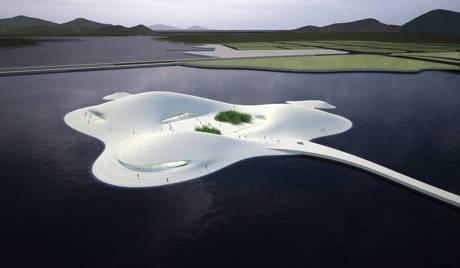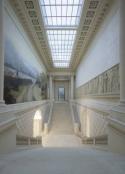Art Of The Day Weekly
#478 - from 22 June 2017 to 28 June 2017

Pingtan Art Museum, Mad Architects, Beijing (exhibition at Musée d'art et d'histoire, Geneva).
IN THE AIR
UFO or cathedral: what will the museum of the XXIst century look like?
GENEVA – A long, chronological frieze outlines the phenomenon of exponential acceleration. The first markers are few and far apart: the Uffizi in Florence in the 17th century, the Louvre in 1793, the new building of the British Museum in 1857. The 20th century is denser, with in particular the Guggenheim in New York by Frank Lloyd Wright in 1959, Pei’s new Louvre in 1989, and the Guggenheim Bilbao by Gehry in 1997. The 21st century seems to be shooting fireworks with more frequency on all continents, as Asia and the Middle East catch up with the Western countries. They too have spectacular creations. A selection of these new museums - recently opened or still under construction, or even interrupted like the Guggenheim Helsinki by Moreau Kusunoki or the China Comic and Animation Museum by MVRDV- show that the architectural gesture has become the founding principle. For various reasons – the most emblematic case is that of the Palestinian Museum at Bir Zeit by Heneghan Peng -, these museums don’t always hold an identifiable collection. Their strange forms though, and the audacity of their design, like the Zeitz Museum set up on former silos in Johannesburg by Heatherwick Studio, or the Pingtan Museum that floats like an island, are enough to turn them into venues worth a visit in itself. Hence a sometimes disquieting thought: while museums have never attracted as many visitors, they are not always being visited as sanctuaries of knowledge or of –even questionable! – art. They are increasingly seen as places to distract, or to go on shopping sprees. The patron muses must be quite moved, sitting up there in their ether! A theme park is not necessarily a place of learning. New museums must know how to stay a cultural and educational course, an aim not always clearly included in their specifications.
• Musées du XXIe siècle. Visions, ambitions, défis at the Musée d’art et d’histoire, from 11 May to 20 August 2017.
Centro Botín, heading to the Cantabria region
SANTANDER - The Banco Santander is the most solid bank in Spain and the Botín family, who controls it, is a financial dynasty not to be overlooked. It was therefore natural, three years after the demise of the patriarch Emilio, that the new center of the Botín foundation, active since 1964, open in Santander itself, the lovely capital of the Cantabria region. Museum maps often neglect it, in favor of its powerful Basque rival, Bilbao, some one hundred kilometers away. The architect is the designer most in demand today in matters of museums, Renzo Piano. The object itself, a glass and steel sandwich open to the famous bay, leaning on stilts, contributes to the revitalization of the former dock district. The institution opens ambitiously, combining cultural activities and educational projects, with three exhibitions. Their content is very varied, thus illustrating the ambition of its policy: a complete retrospective of Carsten Höller, a selection of some one hundred drawings by Goya, and a choice among the purchases of the last twenty years, in which Spanish and Latin American art hold a place of choice with Lara Almarcegui, Carlos Garaicoa or Juan Uslé.
• The Centro Botín opens to the public on 24 June 2017.
Nantes: Italian art, but not only
NANTES – The museum built its reputation on its remarkable fund of Italian art, the property of François Cacault, a diplomat based in Florence and Rome at the time of Napoleon. It therefore holds a beautiful series of gold-grounds, Caravaggio-inspired works, and a few great names such as Perugino or Orazio Gentileschi. But the museum, which opened in 1900 in a huge, typical, “fine arts” style building, was treated to a full, five-year rejuvenation by the British agency Stanton Williams. The result is an enlargement in the form of a luminous cube with a new name, the Musée d’arts de Nantes. We take this opportunity to mention that the institution is also interested in more contemporary forms of art, in particular abstract art with beautiful series by Kandinsky and Manessier, as well as videos by Bill Viola or the personal cabinet of Jean-Jacques Lebel. An interesting aspect of the museum are the local talents who are not always valued as they deserve, such as “academic” artists Delaunay or Picou, talented James Tissot, a genius with cloth, and a strong group of Surrealists, from Pierre Roy to Claude Cahun.
• The Musée d’arts de Nantes will reopen to the public on 23 June 2017.
Perpignan, between Rigaud and Picasso
PERPIGNAN – Native son Hyacinthe Rigaud (1659-1743), was born, like Napoléon, on the eve of seeing his region join the kingdom of France. The son of a tailor, who was surely not meant to have a great destiny, he triumphed at the court of Versailles, where he became the official portrait artist of the powerful Bourbon family, and in particular of Louis XIV and Louis XV. He is represented with dignity in the two hôtels particuliers of Mailly and Lazerme, soberly but elegantly adapted to their functions by the agency Barbotin Larrieu. The rich collection of Gothic works, in a specific Roussillon version, had another interesting period at the beginning of the 20th century when the avant-gardes (Maillol, Matisse, Picasso, as well as local artists such as Terrus) met at Céret or Collioure. It was actually Picasso who painted the billboard for the inauguration: during a less-known period of his life he often visited one of the private homes in which the museum sits today. Between 1953 and 1955, he was often invited by the Lazerme family at a sensitive moment in his life since he had just separated from François Gilot to get closer to his last companion, Jacqueline Roque. In a very warm atmosphere, these summer weeks nourished an unrestrained and joyous creativity: portraits, collages and even towel rails! It was also an opportunity for an impressive ballet of personalities, including Kahnweiler, Leiris, Cocteau, toreros, and even young singer Mouloudji, who interacted with the maestro, either for lunch or at the corrida, before he decided to increasingly isolate himself in his homes on the Côte d’Azur.
• The musée d’art Hyacinthe Rigaud will reopen to the public on 24 June 2017.
AND ALSO
LE HAVRE – Following a six-month renovation campaign financed by the Fondation du Patrimoine and the Fondation Total, the museum of natural history (Histoire naturelle) will reopen its doors to the public on 23 June 2017, in the midst of the celebration of the 500th anniversary of the foundation of the city by François I.
OAKLAND (California) – The Museum of Capitalism opened its doors on 18 June 2017. As it looks critically at the saga of capitalism, it calls in artists, researchers, and historians to participate. The inaugural exhibition studies the relations between capitalism, social classes, and the environment in the U.S.A.
OPENINGS OF THE WEEK

DISPERSION, sculpture by Bernard Pagès
25 June 2017 - BIGNAN - Domaine de Kerguéhennec
An artist who mixes industrial and natural materials



